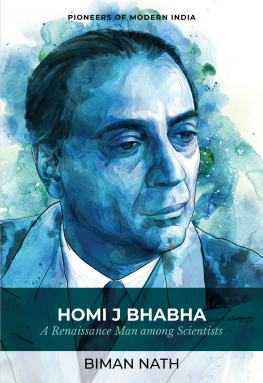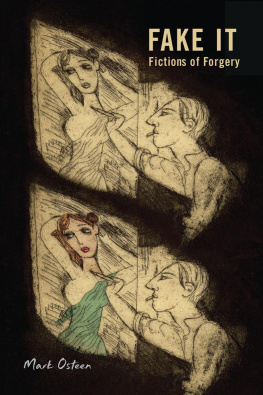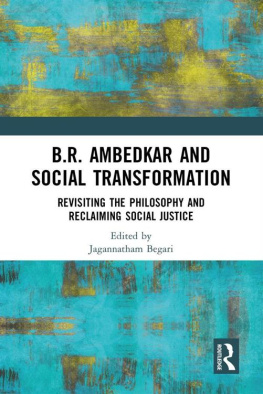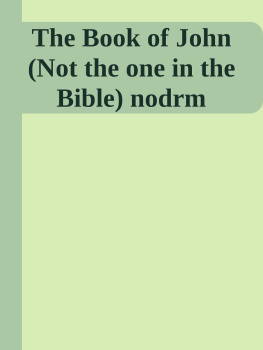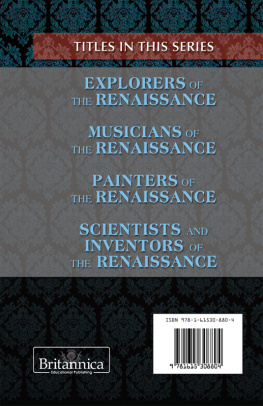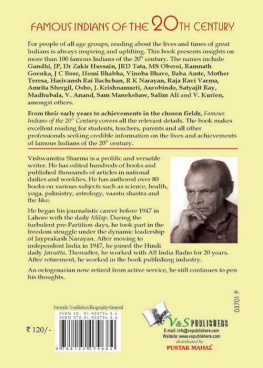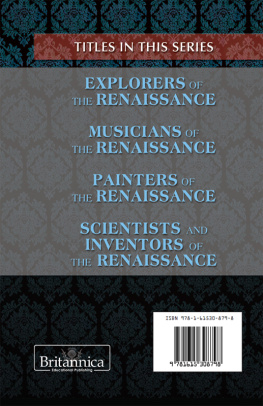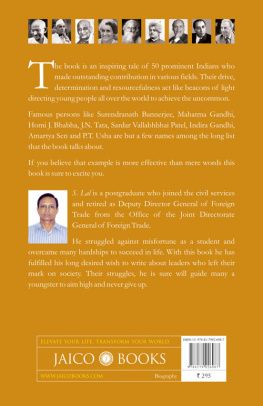Unknown - Homi J Bhabha: A Renaissance Man Among Scientists
Here you can read online Unknown - Homi J Bhabha: A Renaissance Man Among Scientists full text of the book (entire story) in english for free. Download pdf and epub, get meaning, cover and reviews about this ebook. year: 2021, publisher: Paper Missile/Niyogi Books, genre: Non-fiction. Description of the work, (preface) as well as reviews are available. Best literature library LitArk.com created for fans of good reading and offers a wide selection of genres:
Romance novel
Science fiction
Adventure
Detective
Science
History
Home and family
Prose
Art
Politics
Computer
Non-fiction
Religion
Business
Children
Humor
Choose a favorite category and find really read worthwhile books. Enjoy immersion in the world of imagination, feel the emotions of the characters or learn something new for yourself, make an fascinating discovery.
- Book:Homi J Bhabha: A Renaissance Man Among Scientists
- Author:
- Publisher:Paper Missile/Niyogi Books
- Genre:
- Year:2021
- Rating:3 / 5
- Favourites:Add to favourites
- Your mark:
- 60
- 1
- 2
- 3
- 4
- 5
Homi J Bhabha: A Renaissance Man Among Scientists: summary, description and annotation
We offer to read an annotation, description, summary or preface (depends on what the author of the book "Homi J Bhabha: A Renaissance Man Among Scientists" wrote himself). If you haven't found the necessary information about the book — write in the comments, we will try to find it.
Unknown: author's other books
Who wrote Homi J Bhabha: A Renaissance Man Among Scientists? Find out the surname, the name of the author of the book and a list of all author's works by series.
Homi J Bhabha: A Renaissance Man Among Scientists — read online for free the complete book (whole text) full work
Below is the text of the book, divided by pages. System saving the place of the last page read, allows you to conveniently read the book "Homi J Bhabha: A Renaissance Man Among Scientists" online for free, without having to search again every time where you left off. Put a bookmark, and you can go to the page where you finished reading at any time.
Font size:
Interval:
Bookmark:
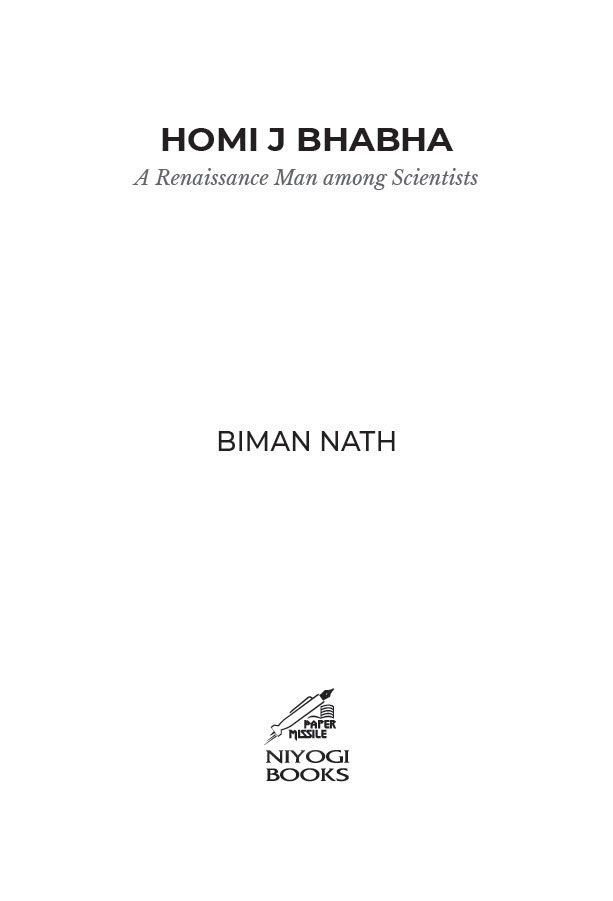
Published by

Block D, Building No. 77
Okhla Industrial Area, Phase-I
New Delhi-110 020, INDIA
Tel: 91-11-26816301, 26818960
Email: niyogibooks@gmail.com
Website: www.niyogibooksindia.com
Text Biman Nath
Editor: Sucharita Ghosh
Layout: Nabanita Das
Cover design: Anurag Hira
Cover illustrator: Douluri Narayana
ISBN: 978-93-91125-11-0
Publication: 2021
Publishers note: Every effort has been made to ensure the accuracy of the information presented in this book. The images used in this book come from either the public domain or from the public commons, unless otherwise stated. The publisher welcomes comments and feedback from readers, in order to improve future editions, at niyogibooks@gmail.com.
All rights are reserved. No part of this publication may be reproduced or transmitted in any form or by any means, electronic or mechanical, including photocopying, recording or by any information storage and retrieval system without prior written permission and consent of the Publisher.
Printed at Niyogi Offset Pvt. Ltd., New Delhi, India
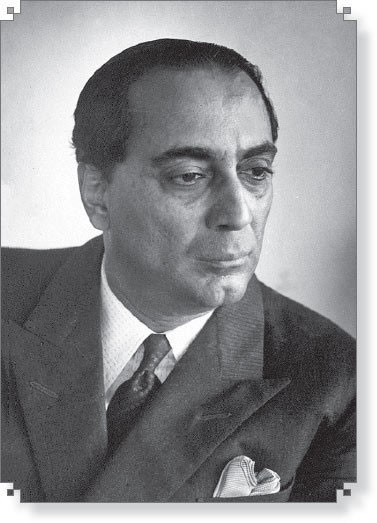
Less than 10 kilometres away from the town of Udhagamandalam, commonly known as Ooty, in the scenic Nilgiri Hills of southern India, a strange sight is likely to bemuse any traveller on a casual foray out of the main town. On one of the grassy hills, there are numerous white buttons spread over the landscape, as if some species of giant mushrooms are being cultivated. On a closer look, they appear to be white-topped structures, each with some set of instruments beneath a metallic roof.
Upon asking the people who tend to these mushrooms, the inquisitive traveller may hear many strange sounding words like muons or air shower, and that the white-topped structures are detectors that keep an eye on particles from the cosmos. And further that this is a part of experiments conducted by scientists from the Tata Institute of Fundamental Research (TIFR) in Mumbai. Upon further enquiry, the name of Homi Bhabha, who had founded the institute, may also pop up.
The traveller may then get to know that there are energetic particles constantly bombarding the Earth from the cosmos, and they are called Cosmic rays. They do not consist of rays of light, but of high energy particles, such as protons, electrons, and atomic nuclei. They are all what can be called sub-atomic particles. Atoms are made of these particles. And when they strike the Earths atmosphere, they collide with air molecules, and trigger a domino effect in which each collision leads to the production of more particles, each with less energy than those from previous collisions. When one cosmic ray particle hits the upper Earths atmosphere, the set of ensuing collisions produce a shower of secondary particles, most of which are lost in subsequent collisions, but among which tiny particles called muons can survive and hit the ground. These are the particles that the mushroom-like detectors have been set up to collect and measure.
It might come as a surprise to the traveller that Bhabha, who had founded the institute that conducts these experiments, was also one of the pioneers in the study of these air showers. The story goes back to the 1930s when muon was still a hypothetical particle, and physicists were wondering about the atomic nucleus. Homi Bhabha was the first person who had worked out the details of the interactions of a cosmic ray particle with air molecules and the structure of an air shower, along with Walter Heitler of Germany. He had asked the questions, such as: How many particleselectrons, protonswould be created at which depth of the atmosphere, if the original particle has a certain energy? The aim was to build a method of tracing back to the energy and characteristics of the original particle once the secondary particles were detected. In a way, this is similar to working out the energetics of a bomb from a measurement of its splinters, although in the case of cosmic rays it is more complicated, since the number of splinters multiplies at every step.
And then the traveller may walk across the field strewn with such detectors, and suddenly see another structure, a set of tall metallic towers holding up an inclined wire mesh, running down the hillside. The wires sparkle in the sunshine on a clear day, making the contraption look like a metallic waterfall. When asked, a technician would tell our traveller that this is a radio telescope, designed to listen to radio signals from the far ends of the cosmos. One might wonder why one needs to eavesdrop on cosmic signals, and why build a detector shaped like a mammoths trunk for that purpose, and, why on earth build it in the Nilgiri Hills of all places. Scientists working with the Ooty radio telescope would patiently answer each of these questions, and again the name of Bhabha might crop up, because these experiments are also being conducted by astronomers from TIFR. This was the first big radio telescope built in India, by a maverick engineer-astronomer named Govind Swarup, who was encouraged from the day zero of his joining the institute by none other than Homi Bhabha to make radio astronomy a viable topic of research in India. And a bit of looking around on the internet would tell anyone that their vision has not failed. Radio astronomy has become one of the success stories in Indian science, and it started here in the hills near Ooty.
There is also a connection between the two sets of detectors, one for measuring muons and the other for radio signals. Often the radio signals are from remnants of gigantic explosions of massive starsexplosions that are called supernova. These supernova remnants move with such high speedthousands of kilometres per secondthat they shock the surrounding gas, often hurling some of the gas particles and pushing them to high energy, to become cosmic ray particles. Some of these particles rain down on the Earth and cause air showers that are detected on the other side of the hill.
From keeping track of air showers and muons shooting through the atmosphere, to recording cosmic radio signals, this sneak preview of the activities of scientists in Nilgiri Hills gives us a glimpse of the work and vision of an extraordinary man. One can even say that any account of Indian science would be incomplete without the story of Homi Jehangir Bhabha. He was not only a builder of institutions, but was also intimately involved in the scientific research carried out in those places and, in some cases, he was the pioneer of such research.
Consider the muons for example. When similar particles called pions were discovered, Bhabha had pointed out an interesting fact that also applied to muons. These particles, muons and pions, decay into other particles after a certain amount of time (about 2 microseconds), just as some atomic nuclei radioactively decay into other nuclei. Suppose an air shower produces a number of muons at a height of 10 kilometres above the ground. These are tiny and light particles and travel at speeds close to that of light. One can ask how many muons are likely to reach the ground before they decay into something else. A straightforward calculation would reveal that if there were three million muons at that height then just about one would survive at ground level if they travel at 99 per cent of the speed of light.
Font size:
Interval:
Bookmark:
Similar books «Homi J Bhabha: A Renaissance Man Among Scientists»
Look at similar books to Homi J Bhabha: A Renaissance Man Among Scientists. We have selected literature similar in name and meaning in the hope of providing readers with more options to find new, interesting, not yet read works.
Discussion, reviews of the book Homi J Bhabha: A Renaissance Man Among Scientists and just readers' own opinions. Leave your comments, write what you think about the work, its meaning or the main characters. Specify what exactly you liked and what you didn't like, and why you think so.

